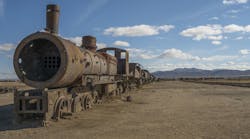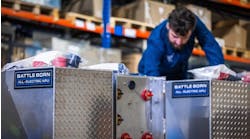(BLOOMBERG) — The rail downturn underscores the damage from the U.S.-China trade war, which is making shippers more cautious and crimping freight — validating earlier warnings from railroad executives. Companies that stocked up on inventory last year amid President Donald Trump’s tariff threats are now working it off. Adding to the cargo drop, a brief rise in coal exports has fizzled and bad weather has delayed crop harvests and dragged down grain carloads.
“What’s quite clear is that we’re not yet at a trough — trains have not yet bottomed,” said Ben Hartford, an analyst with Robert W. Baird & Co. “We need to have some clarity in trade policy.”
While a railroad recession doesn’t necessarily presage a broader slump, it’s a dramatic turn from 2018, when rising shipments of autos, coal, lumber, chemicals and other commodities spurred U.S. rail carloads to rise 3.6%. Last year’s hot freight market jacked up trucking prices, and transportation costs spiked for companies including General Mills Inc. and Procter & Gamble Co.
‘No Pockets’
Now, “there are no pockets of growth,” said Bloomberg Intelligence analyst Lee Klaskow, who sounded the alarm about a “railroad recession” in a recent report. “There’s really nothing that’s tapping me on the shoulder saying, ‘Hey look at me. I’m going to be your next growth engine.’”
A rail recession doesn’t automatically translate into a general economic downturn, Klaskow said. The U.S. economy continued to expand when carloads fell 2.1% in 2015 and 4.5% in 2016, after a crude-by-rail boom went bust.
Investors are partially insulated from the recent drop because earnings are holding up at the four large publicly traded railroads in the U.S., which have adopted an efficiency strategy developed by Hunter Harrison. The industry guru died in 2017 after overhauling CSX Corp. with his “precision scheduled railroading” approach.
CSX is the only major U.S. railroad that is poised to see earnings drop in the third quarter from a year earlier. Increases are expected at Union Pacific Corp., Norfolk Southern Corp. and Kansas City Southern, which adopted the efficiency techniques after CSX and are still reaping the rewards.
That’s shoring up the railroads’ shares, although only Kansas City Southern is outperforming a Standard & Poor’s index of U.S. industrial companies. The S&P 500 Railroads Index has risen about 13% this year.
While the market is well aware that freight demand “meaningfully decelerated” in the third quarter, pricing and the share of lower-profit loads “may still surprise to the downside,” Ravi Shanker, an analyst with Morgan Stanley, said in a Monday report.
Factory Slump
Carloads at BNSF Railway Co., the U.S. railroad owned by Warren Buffett’s Berkshire Hathaway Inc., dropped only 2.9% in the third quarter. That was better than the 8.6% plunge at its rival in the western U.S., Union Pacific. And cargo volumes have held up better at Canadian Pacific Railway Ltd. and Canadian National Railway Co., as more maritime cargo from Asia shifts to Canadian ports.
But in the U.S., sagging freight shipments are taking a toll.
The Institute for Supply Management’s factory index slipped to 47.8 in September, the lowest since June 2009. It was also the second straight month the index was below 50, which signals contraction.
Truckers are also feeling the pain. Less-than-truckload cargo, which tends to be tied to industrial production, plummeted 12% in August from a year earlier. Freight carried by long-haul trucking is still growing as consumer spending holds up. Truck cargo prices, though, have dropped.
Cheaper trucking rates are pulling some freight from rails. But even if that trend moderates next year and the decline in rail carloads slows, there’s no guarantee of growth — especially if the factory weakness drags down consumer spending.
“That’s the risk at this point in time: that the consumer does begin to show impacts from the pain that we see on the manufacturing side,” said Hartford, the Baird analyst. As for rail freight, “when is it going to turn? I honestly have no idea.”



